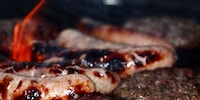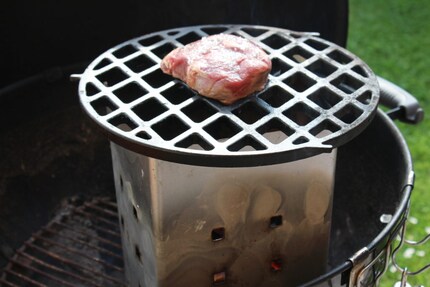
Background information
Kettle barbecue tutorial part 1: The kettle barbecue - a real winner
by Daniel Haupt

Now that we have an understanding of what makes our kettle barbecue tick and how to get a good grip on the temperature, it would be really nice to find out what you can do with it. How do I place the coals for which food, what is meant by "indirect" grilling and how do I achieve a perfect steak?
When arranging your embers on the kettle barbecue, you should always be aware of the food you want to cook beforehand. But perhaps I'll show you the main options first.
In general, a distinction is made between the following different heat zones in the kettle barbecue:

(Image: www.project-bbq.de)
With the so-called two-zone glut, I have - surprisingly - exactly two different heat zones: One with direct radiant heat and an indirect area. I can use this setup perfectly to grill several pieces of meat directly and then finish cooking them slowly in the indirect area.
The setup in the centre illustration shows what is known as indirect heat. Here, direct heat is generated on the left and right and there is a large indirect area in the centre. I usually choose this setup if I want to cook a large piece of meat indirectly.
The three-zone grill is a combination. Here, the coals are stacked from one side downwards. This gives me direct high heat, another area with direct but not quite as high heat (due to fewer coals) and an indirect area.
I roast flat pieces of meat such as chops, pancetta, pork neck steaks or beef steaks directly over the direct radiant heat. As the grill grate also has a good temperature here, the meat develops the popular grill pattern and the much-loved grill flavours.
In order to achieve this grill pattern and conjure up a nice crust on my steak, the temperature should be around 200 - 250 degrees. In these temperature ranges, the so-called Maillard reaction comes into effect and conjures up the roasted flavours by converting amino acids and sugars on our grilled food.
Indirect heat is what is reserved for a closed barbecue system such as a kettle barbecue, but also for most gas barbecues. It allows you to cook food slowly and gently, similar to an oven. The food usually remains incredibly juicy and flavourful.
The indirect area is used to "post-cook" thicker pieces of meat. A three-finger-thick steak would look pretty burnt on the outside if we were to finish grilling it over direct heat. As the embers in the indirect area are not directly under the meat, it cannot burn and is cooked exclusively by the abundant hot air in the kettle grill.
An indirect area is also useful whenever the embers get too hot. Then I can quickly move food to this area so that nothing burns.
When indirectly grilling large pieces of meat such as whole roasts, chicken, minced meat and other things, a barbecue thermometer is essential. Different types of meat have different cooking points, which can be determined based on the temperature inside the meat, the so-called core temperature.
With a wireless thermometer, barbecuing becomes a completely relaxed affair. Once the barbecue is set to the desired temperature, insert the probe of the barbecue thermometer so that the tip is approximately in the centre of the piece of meat and then just wait. Grab a beer and sit back.
A drip tray is always a good idea if you are cooking large pieces of meat slowly and indirectly. Why?
It's quite simple. The drip tray is filled with water in advance. Make sure you use hot water here so as not to cool down the grill unnecessarily.
The water tray keeps the air inside the barbecue moist and prevents the food from drying out. In addition, dripping fat and liquid is collected and does not spoil your barbecue.
You can also add a smoky flavour to your meat by adding smoking chips. To do this, simply place the smoking chips in the embers
If you want to add a smoky flavour to your meat, always place the smoking chips on the embers at the beginning. The rougher and cooler the food is, the better it can absorb smoke flavours.
You often read that you should water the smoking chips before use, sometimes it is even written on the packaging of the smoking chips themselves.
I say: humbug! We want to add smoke flavour to our meat, not cook it in steam. If you put wet wood on your coals, you're ultimately only doing one thing: cooling down the embers! Believe me, dry chips smoke just as well, if not better.
Finally, I have a little insider tip on how you can prepare a great steak in your kettle grill without much effort. With the help of the chimney grill
.
This works best with the cast iron insert for the Weber GBS system. But you can also use the normal grill grate.

Fill a barbecue fireplace one third full with charcoal and light it. As soon as the charcoal is glowing nicely, place the grill grate on top of the chimney and grill your steak for about 3 minutes on each side.
On a normal grill grate, you can turn the steak by approx. 60° after every 90 seconds to create a diamond pattern, but you don't have to do this with the cast iron grate.
After grilling, remove the grill and place the coals on one side of your barbecue. As we haven't used many coals, the grill won't get too hot, but will have a temperature of around 150°. Perfect for bringing your steak to the desired core temperature in the indirect area.
I was born in the Rhineland, am a project manager in IT and a family man. Away from ones and zeros and at the latest with the move into our home I have found my only true project: The barbecue!
<br /><br />
Since 2015 I have been writing about this on my blog. There I give my readers all sorts of tricks and tricks about barbecuing with charcoal and present my latest creations and ideas.
<br /><br />
You'll find more of me here:
<a href="http://project-bbq.de" target="_blank">project-bbq.de</a>
Interesting facts about products, behind-the-scenes looks at manufacturers and deep-dives on interesting people.
Show all